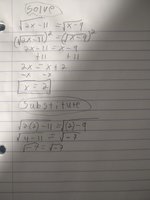chromechris
New member
- Joined
- Jan 21, 2018
- Messages
- 24
I was solving the following problem, but am unsure if it is ok to solve it the way I am doing it, because I am afraid that I am changing the content of the answer. Here is the problem I was working on:
[MATH] Solve for v, where v is a real number. [B]√[/B]8v-11 = [B]√[/B]6v+9 What I would do to solve this: ([B]√[/B]8v-11)[SUP]2[/SUP] = ([B]√[/B]6v+9)[SUP]2[/SUP] 8v-11=6v+9 Subtract 6v from both sides 2v-11 = 9 Add 11 to both sides 2v = 20 Divide both sides by 2 v = 10 [/MATH]
Now, I am not sure if it is ok to square both sides like I did in my first step, because like I mentioned earlier, I don't want to change the content of the equation (I'm not sure if I am doing so or not by squaring both sides). I made up a sample problem to help me see if I was doing so, and I think I was, here is the sample problem:
[MATH] Problem: 3 = [B]√9 Solution: 3=3 Now if I square both sides, the equation is true, but the value of it changes: (3)[SUP]2[/SUP] = ([B]√9)[SUP]2[/SUP][/B] 9 = (3)[SUP]2[/SUP] 9 = 9 The value went from 3 to 9[/B] [/MATH]
I guess I am looking for clarification to know if squaring both sides as my first step for the first problem I listed is ok, and why doing so is not changing the content of my answer (I don't know if it is or is not).
[MATH] Solve for v, where v is a real number. [B]√[/B]8v-11 = [B]√[/B]6v+9 What I would do to solve this: ([B]√[/B]8v-11)[SUP]2[/SUP] = ([B]√[/B]6v+9)[SUP]2[/SUP] 8v-11=6v+9 Subtract 6v from both sides 2v-11 = 9 Add 11 to both sides 2v = 20 Divide both sides by 2 v = 10 [/MATH]
Now, I am not sure if it is ok to square both sides like I did in my first step, because like I mentioned earlier, I don't want to change the content of the equation (I'm not sure if I am doing so or not by squaring both sides). I made up a sample problem to help me see if I was doing so, and I think I was, here is the sample problem:
[MATH] Problem: 3 = [B]√9 Solution: 3=3 Now if I square both sides, the equation is true, but the value of it changes: (3)[SUP]2[/SUP] = ([B]√9)[SUP]2[/SUP][/B] 9 = (3)[SUP]2[/SUP] 9 = 9 The value went from 3 to 9[/B] [/MATH]
I guess I am looking for clarification to know if squaring both sides as my first step for the first problem I listed is ok, and why doing so is not changing the content of my answer (I don't know if it is or is not).

